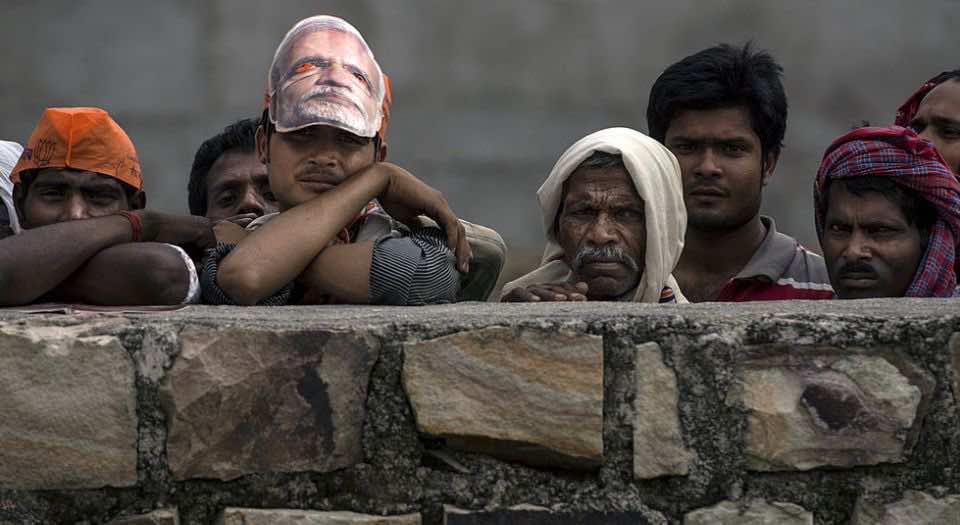
Long-read
India’s dialectic of progress
Two new books show how far post-independence India has come, and how far it has still to go.
Last November, trying to suppress corruption, Narendra Modi’s rightist government in India banned 500- and 1000-rupee notes overnight, bringing chaos. In July 2017, in the face of much apprehension, but trying to lubricate commerce, it introduced a uniform set of goods and services taxes across India’s 29 states and seven centrally governed union territories.
Clearly Modi prefers tinkering with cash and taxes to taking more fundamental measures. His 2014 Make in India campaign promised to raise manufacturing’s percentage of India’s GDP to 25 per cent by 2020; but it’s risen just 0.1 per cent, to 16.5 per cent. Having proclaimed ‘Toilets first, temples later’, Modi has overseen the building of just 44.6 million, between 2014 and 2017: he’ll not meet his 2019 deadline for ending open defecation. In research and development there’s a similar story. At just 0.85 per cent of GDP (China spent 2.07 per cent in 2015), the government’s budgets for R&D fall so much behind its rhetoric about science that, ‘every year’, one authority says, Indian scientists get ‘disillusioned’.
Modi won’t create the million jobs a month India needs for 20 to 30 years if it’s to absorb its expanding population (1.33 billion; the figure for China may be 1.29 billion). So though India’s GDP is growing at seven per cent a year, and Modi’s liberalisation of inward foreign direct investment saw it rise to a record $60 billion in 2016-7 (China’s is $118 billion), India’s problems are multiplying.
Some fear it faces ‘premature deindustrialisation’. More tenuously still, others believe that the automation they dream is sweeping through the West will make India’s labour market very vulnerable to IT – whether directly, in India, or indirectly, through the much-noised, little-seen ‘reshoring’ of factories back to the West. But beyond real and imagined economic travails lie others. Religious tensions, corruption and the oppression of women remain serious. The official ‘reservation’ of jobs for lower castes is more and more divisive. Free speech is under attack. India’s air pollution, and its longstanding disputes with China and Pakistan, worsen.
These books – Shashi Tharoor’s Inglorious empire: what the British did to India and Vijay Joshi’s India’s long road: the search for prosperity – are timely. Tharoor’s treats British imperialism’s historic degradation of India; Joshi’s, the economy after independence in 1947.
Just in passing, we should note that Tharoor has won rave reviews not just from the Guardian but – repeatedly – from the Financial Times. Now why would the FT suddenly endorse an indictment of the British? The reason is that, in belatedly discovering how horrible they were to the Indians yesterday, the FT wants to destroy Brexiteer hopes that British business will be able to profit from India tomorrow – ‘Empire 2.0’, as Britain’s Remainer civil servants sarcastically term it. Perhaps the FT is right; but when prime minister David Cameron went to Delhi to suck up to Indian capitalists in 2013, it blithely contended that he should go ‘well beyond’ economic diplomacy.
To resume: a Congress Party MP and once a United Nations bigwig, Tharoor feels obliged to attack not just the praise lavished on the British Empire by the right-wing Scots historian Niall Ferguson, but also… Karl Marx. Ferguson’s Empire (2003) argued that Britain helped its subjects through an early globalisation of its economic, legal and political system. Tharoor replies that Britain in India meant ‘ruin to millions, the destruction of thriving industries, the systematic denial of opportunities to compete, the elimination of indigenous institutions of government, [and] the transformation of lifestyles… that had flourished since time immemorial’. Triumphantly, he adds that, in this, ‘the likes of Ferguson are, ironically, following no less a predecessor than Karl Marx’, going on to extract, from one of Marx’s most famous articles on India, this passage, published in 1853:
‘Indian society has no history at all, at least no known history. What we call its history, is but the history of the successive intruders who founded their empires on the passive basis of that unresisting and unchanging society. The question, therefore, is not whether the English had a right to conquer India, but whether we are to prefer India conquered by the Turk, by the Persian, by the Russian, to India conquered by the Briton. England has to fulfil a double mission in India: one destructive, the other regenerating the annihilation of old Asiatic society, and the laying of the material foundations of Western society in Asia.’
That’s enough for Tharoor to bracket Marx with Ferguson as an apologist for British rule.
Many critics of Marx level the same charge: in their trendy Empire (2000), the leftists Michael Hardt and Antonio Negri, quoting the same final sentence of Marx, accused him of ‘scant knowledge’ of India, and of ‘Eurocentrism’.
In fact Marx’s very next paragraph insisted that Britain destroyed India ‘by breaking up the native communities, by uprooting the native industry, and by levelling all that was great and elevated in the native society’. But Marx did indeed argue that Britain improved the political unity of India. Britain, Marx also wrote, gave India its native army (‘the sine qua non of Indian self-emancipation’); a free press; ‘abominable’, but at last private, property in land; a governing class ‘imbued with European science’; steamboats, the railways and, with rail, the chance to extend irrigation. Marx continued, scathingly and significantly:
‘All the English bourgeoisie may be forced to do will neither emancipate nor materially mend the social condition of the mass of the people, depending not only on the development of the productive powers, but on their appropriation by the people. But what they will not fail to do is to lay down the material premises for both. Has the bourgeoisie ever done more? Has it ever effected a progress without dragging individuals and people through blood and dirt, through misery and degradation?’ (Emphases mine).
Tharoor movingly describes the Raj’s looting of India (the verb is Hindu). He is right that there were important moves toward Indian unity before the Brits came, and may even be right that the real thing could have happened without them – but, as he observes, such a counterfactual history is ‘impossible to prove’. He grants that India’s independence movement couldn’t have spread without a free press; says that Britain never wanted democracy for Indians, even if Indians went on to install a parliamentary system; delineates how Britain ruthlessly pursued a policy of divide and rule, and, very properly, ridicules Ferguson for upholding British law in the colonies. Indeed, the British historian Lord Macaulay’s penal code, enacted in 1861, had the avowed purpose of legislating for a conquered race, and is, Tharoor notes, ‘still largely in force in India today’.
Tharoor shows how the railways were built and run to aid Britain, and actively harm Indian interests. His mistake is to focus almost exclusively on capitalism’s regressive side – though he likes Britain giving India the joint stock company and Asia’s oldest stock exchange (Bombay, 1875). Certainly the railways worked for Britain; but railways are still railways, even if Britain established them, like ports and buildings, ‘with the minimum amount of investment to optimise their exploitation of Indian wealth’. Indeed, Tharoor is forced to allow that, even today, Indians could not live without Britain’s old rail system. Similarly, he credits Britain with irrigating an area the size of France – ‘almost all of it, alas, in Pakistan today’, he adds, revealingly.
In the realm of productive forces, then, Britain did indeed transform the ‘timeless lifestyles’ that Tharoor, like Mahatma Gandhi before him, eulogises. Entirely bestial though the process was, it undeniably laid the basis for future progress. This does not mean, as India’s long discredited Stalinists have always maintained, that imperialism as a whole was progressive, or a historically necessary stage in an inevitable trajectory toward socialism. It is just to recognise, in a dialectical fashion, that the results of imperialism were not 100 per cent negative.
It’s no surprise that Tharoor traduces Marx. The British legacy he never mentions is how, after studying in the UK, elitist Fabian socialism influenced Jawaharlal Nehru and a generation of Congress Party leaders. In a Fabian whitewash, Tharoor presents far too rosy a picture both of Labour’s role around Partition, and of post-war Indian development.
For the Fabians, enlightened and elitist administrators could use the capitalist state to benefit the masses. Yet Britain’s 1894 Land Acquisition Act, which for more than a century enabled Delhi to buy farmers’ land at outrageously low prices, alone shows how wrong this view is. No wonder Tharoor passes over the vital issue of land in India. Likewise, he trumpets that India electrified its villages 320 times faster than the British, 1947-91; but his own sums show that this still left a full quarter without power. Correctly but fleetingly, he laments that, after 1947, India ‘spent 45 years with bureaucrats rather than businessmen on the “commanding heights” of the economy… subsidising unproductivity, regulating stagnation and trying to distribute poverty’. So why is he still a Congress man?
Joshi goes much further in showing the damage Congress did. He describes how, taking a leaf from Stalin, postwar Indian bureaucrats staked everything on state controls, massive but unfruitful investment in heavy industry, and the utopia of socialism in one country. The result? As late as 1978, more than half the population remained below the official poverty line. Today malnutrition, illiteracy and infant mortality are still appalling, even if concentrated in certain states, while general health, like education and infrastructure, is a mess. Yes, independence allowed India to up its growth rate from one per cent to 3.5 per cent, between 1950 and 1980. But as Joshi says, this ‘Hindu rate of growth’, as it was mocked, was a major disappointment.
Joshi’s statistics are excellent. He highlights the low productivity brought about by India’s idiosyncratic paucity of large and medium firms. Indeed, small firms dominate not only in agriculture, where they take almost all of output and employment, but also in industry (30 per cent of output, 87 of employment) and services (55, 85). Joshi insists, too, that India’s labour regulations protect the small minority of workers in the public sector and larger firms at the expense of those outside. India’s corrupt trade unions connive in this.
Joshi remarks that Congress’ Indira Gandhi broke a 1974 nationwide rail strike with ‘some display of brutality’, and that her 1975-7 Emergency had ‘some of the characteristics of a police state’. He misses both her contemporaneous forced sterilisation of six million men, which was backed by the UN and the World Bank, and Congress’ 2013-4 sterilisation of four million women. Still, Joshi does at least note that just 30 per cent of Indian women have jobs – less than half the rate achieved by China.
Impeded by stagnant agriculture and unable to reap productivity gains by shifting jobs out of that sector, India nevertheless grew by well over five per cent a year between 1980 and 2000; unlike the rest of East Asia, it was services, not manufacturing, that helped here. The Reagan/Thatcher 1980s, however, was in India marked by high state spending and borrowing, shallow reform, a big drop in the ratio of output to capital investment, and Indira Gandhi’s statism, which exceeded even that of Nehru. Still, the 1990s saw output-to-capital ratios improve somewhat, while private sector and especially corporate capital formation soared. Why?
For Joshi the balance of payments crisis of 1991 prompted a more decisive liberalisation than Indira Gandhi ever attempted, even if there was little shakeout of weak firms (the ‘destruction’ bit of creative destruction). The reforms launched that year also reintegrated India into the world economy after many years of relative autarchy. When the Eastern Bloc collapsed, Joshi writes in a single throwaway line, so too did the respectability of India’s earlier strategy.
Like R&D and technological innovation, Joshi gives the end of the Cold War no attention. Yet the atmosphere that epochal moment created had an immense economic (as well as political) impact – and not just in India: it helped, for instance, in the consolidation of the Hong Kong stock exchange, and in the founding of exchanges in Shanghai and Shenzhen.
Joshi’s framework is mostly fiscal, and involves physical capital, human capital and that old but still trendy Green canard, natural capital. Like Mahatma Gandhi, he wants to revive labour-intensive manufacturing more than to develop high-tech industry and services. He is right that state subsidies have benefited big, rich buyers of energy, fertilisers and water, not poor ones; but, in a Green manner, he forgets how ending subsidies and allowing prices to rise for these items would still impoverish the poor.
Joshi’s concluding assessment of the Modi regime is balanced, but damning. It has plenty of targets, missions and projects, but no broad vision of economic reform. Public-sector enterprises still lose India a ‘staggering’ one per cent of GDP a year. On the current course, Joshi says with considerable understatement, it’s ‘doubtful’ that India can quintuple income per head, reaching the levels currently enjoyed by Portugal and Greece, any time before 2040.
Clearly that course will have to change. In the meantime these two books, for all their faults and omissions, are recommended.
James Woudhuysen is visiting professor of forecasting and innovation at London South Bank University. He is also editor of Big Potatoes: the London Manifesto for Innovation. Read his blog here.
Inglorious empire: what the British did to India, by Shashi Tharoor, is published by Hurst & Co. (Buy this book from Amazon(UK).)
India’s long road: the search for prosperity, by Vijay Joshi, is published by Oxford University Press. (Buy this book from Amazon(UK).)
To enquire about republishing spiked’s content, a right to reply or to request a correction, please contact the managing editor, Viv Regan.







Comments
Want to join the conversation?
Only spiked supporters and patrons, who donate regularly to us, can comment on our articles.